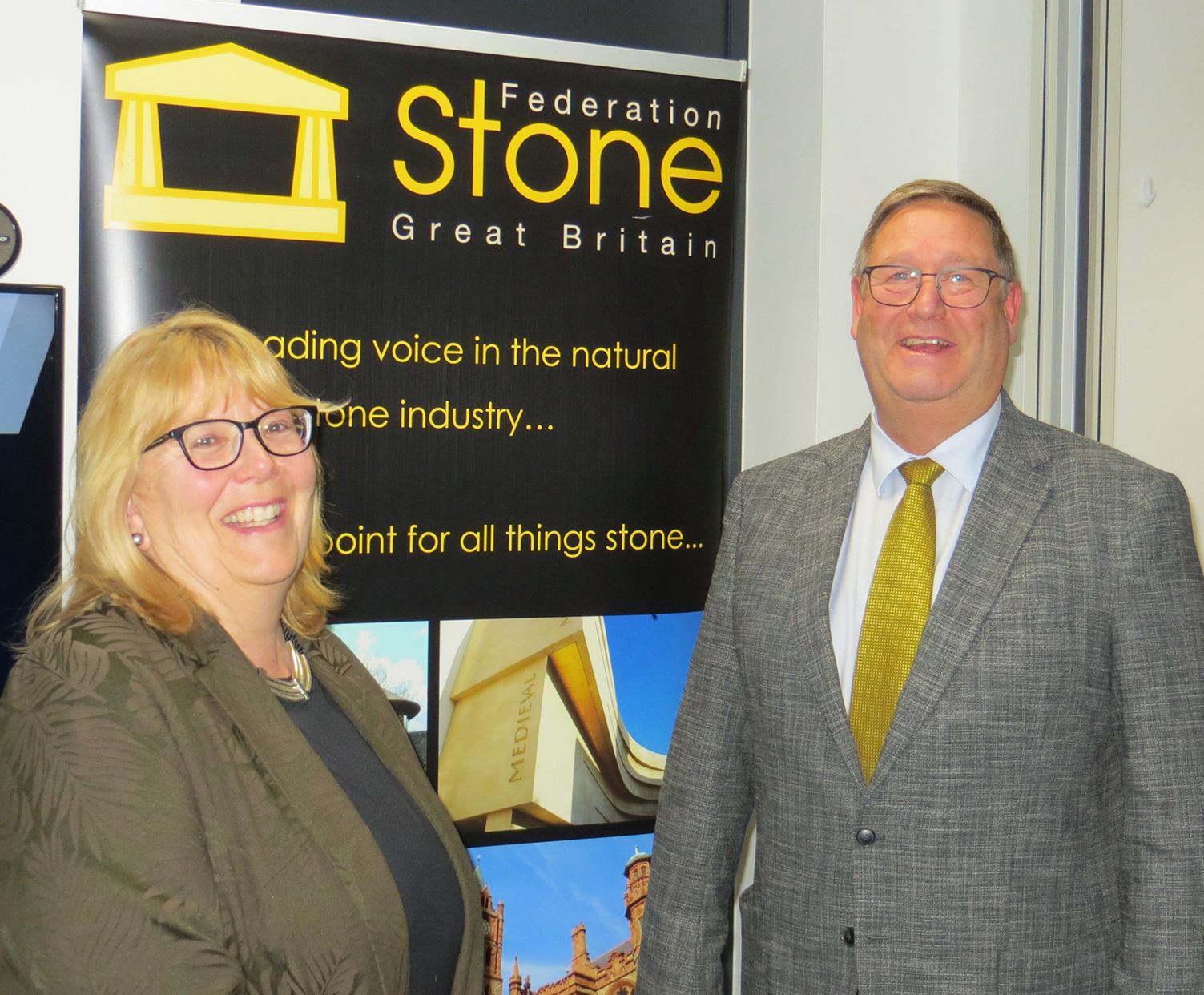There is strength in numbers, which is why one of the areas Chris Kelsey is concentrating on during his two years as President of Stone Federation Great Britain is encouraging more companies to join the Federation. And with some success, as more companies have joined.
That was part of the good news at the Federation’s annual Members’ Event and general meeting, held this year at member Arup's offices in Manchester on 28 March.
“We are stronger as an industry if we all work together,” said Chris Kelsey. That’s particularly true when times get tough, and Federation Chief Executive Jane Buxey said: “It’s commercially brutal at the moment.”
With the benefits of the government’s Covid cash injections petering out, and prices and interest rates rising, the high levels of demand seen in the two years following the first Covid lockdown in 2020 are noticeably easing.
Jane Buxey reminded members that the more they participate in the Federation’s activities and initiatives, the more benefits they will discover from their membership and Chris Kelsey said: “If we continue to work together we will have a future to be proud of.”
Chris Kelsey also said he is keen that the voice of the stone sector should be heard when it comes to British and European standards that affect the industry. And he said he is supporting the publication of more technical documents from the Federation to add to those already valued by the industry, architects and clients, and he urged members to contribute to them when asked.
The Federation is taking its own advice on collaboration by working with organisations such as the Construction Leadership Council and the Construction Industry Training Board (CITB), and strengthening its relationship with the Minerals Products Association.
Stone Academy
One difficulty stone companies are facing (although they are certainly not alone in this) is the recruitment and retention of staff. The Federation’s response is the creation of a Stone Academy, something Jane Buxey has been developing for some time.
This will replace StoneTrain, the Federation’s training arm, with a more comprehensive training body encompassing 25 career opportunities in the stone industry, covering skills such as quarrying, surveying and draughting as well as masonry.
It will encourage Stone Federation members to undertake lifetime training through continual professional development (CPD), presenting career paths through what Chris Kelsey described as a “training matrix” to elevate the industry in the vocational stakes, making it more professional and more attractive as a career to a greater number of people.
Stone Federation’s Digital Media Executive, Matt Robb, described the Academy as providing “pathways of progression” that could make the stone industry a “genuinely attractive industry to be part of”, because when there are clear opportunities to progress people tend to stick around.
Chris Kelsey emphasised the Academy will be providing additional training, not simply be attempting to replace what already exists. He described it as “training for the industry by the industry”.

Focus Groups
The Federation has a number of focus groups in which members involved in particular aspects of the industry can participate. There is the Quarry Forum, the Heritage Focus Group, the Landscape Forum and the Interiors & Surface Materials Focus Group. Reports from each, outlining their activities of the past year, were presented during the Members Event and it was clear video CPDs for presentation to architects have become an important part of the groups’ activities.
The Quarry Forum had actively engaged with the government’s consultation process on its Planning White Paper with the help of Sam Thistlethwaite, the minerals planning consultant who has been advising Stone Federation on this issue and helping it form its responses to government consultations on planning. Sam has helped the quarries engage with more than 60 local authorities on the development of Local Design Codes, which will roll out across the country, ensuring natural stone is included. (Read Sam’s latest report on planning with Stone Federation here).

Women In Natural Stone
Another group under the Stone Federation wing is Women in Natural Stone (WINS), which had its own lunch meeting at Brown’s in Manchester ahead of the late afternoon Stone Federation Members Event and AGM, which several of the WINS members also attended.
WINS has lately established a mentoring programme so that women joining the industry can be given guidance and assistance by those already well-established in it. This is to help this male-dominated sector to benefit from a greater level of diversity. Jane Buxey described WINS as an “overwhelming success”.
The Industry Choice Stone Award
No Stone Federation review of 2022 would be complete without a mention of the Natural Stone Awards, presented in December by architect, TV presenter and sustainability advocate Charlie Luxton at the Leonardo Royal London Tower Hotel in front of an audience of 360 architects, main contractors, designers, clients and stone industry companies.
It is described in the annual report as a “wonderful day” celebrating the best that the industry has to offer. You can see the souvenir brochure showing all the projects honoured in the Awards on bit.ly/NSA22Brochure.
During the Awards presentation event it was announced that the industry would be given a chance to choose their favourite from among the winners of each of the eight categories in the awards, covering all aspects of architectural stonework from new build to conservation, carving, interiors and hard landscaping.
The project that receives most votes will be presented with the Industry Choice Award. The winner will be announced during the Natural Stone Show at ExceL in London 6-8 June. You can see the winning projects and cast your vote at www.stoneshow.co.uk/vote-industry-choice-award-winner.
The Ethical Stone Register and EPDs
Stone Federation’s Digital Media Executive, Matt Robb, reminded members it wants them to join its Ethical Stone Register, which was launched in 2016 when the Modern Slavery Act came into force. Its aim is to help stone companies of all sizes to demonstrate their commitment to tackling modern slavery and human rights abuses in stone supply.
“We are aware this is an ever-changing landscape,” said Matt, pointing out that the Register’s responsible sourcing pledge is linked to the government’s Net Zero carbon ambitions as well as human rights.
Matt said the Register is gaining traction and could become a qualification requirement for specification documents. He said discussions are currently under way with three of the top main contractors who want to use resources like the Ethical Stone Register to strengthen their own ethical trading credentials. He reminded members “it’s here to serve the British stone market”.
EPDs (environmental product declarations) are also starting to be required and Stone Federation is working with One Click LCA (life cycle assessment). It enables companies to produce low cost EPDs in a matter of weeks using the One Click pre-verified EPD generator, which it describes as an automated tool to develop robust EPDs that comply with ISO 14040, ISO 14044, ISO 14067, EN 15804+A1+A2, ISO 21930 and ISO 14025.
Matt said Stone Federation will be presenting a “what, why and how” of EPDs at the Natural Stone Show at ExCeL London 6-8 June. Stone Federation will, as ever, be at the heart of the Stone Village of its members at the Natural Stone Show.
Matt said Stone Federation has been promoting the low carbon sustainability of natural stone for more than a decade and it is now right at the top of the agenda. And while the impressive sustainability of stone has not changed, many other building materials are now promoting their own claims to low carbon sustainability.
Matt said natural stone is the sustainable, carbon responsible choice for construction and that is a message the industry has to promote.
The Building Safety Act 2022 will change everything
Although the Building Safety Act of Parliament that was given the Royal Assent in April last year and should be fully implemented by October this year was a response to the fire at Grenfell Tower in London, it will affect every aspect of construction.
That was the stark statement by Tim Yates of BRE, giving a report on behalf of Stone Federation’s Health & Safety Forum, which is always one of its best attended groups, drawing interest from across all the various sectors of Federation membership.
Tim said: “The Building Safety Act will permeate every bit of the construction industry over the next few years. It will change the way everything is done. As an industry we need to be aware of that.”
Central to the new regime is the creation of a national Building Safety Regulator (BSR) and the identification of an Accountable Person.
The national Building Safety Regulator (BSR) is part of the Health & Safety Executive (HSE) with responsibility for monitoring the safety and standards of all buildings in England, encouraging increased competence in construction and among building control professionals, and leading the implementation of a new building control approval regime for the design, construction and refurbishment of higher-risk buildings like Grenfell Tower.
The Accountable Person is part of a ‘golden thread’ of vital information to safeguard building users against risks such as fire and structural faults in all buildings.
This ‘golden thread’ of information is the core of the Act. It requires all information and documents relating to any building to be collected in one, centrally held digital record, so anyone can find it.
The obligation for avoiding risks falls on duty holders among designers and contractors and the individual identified as the Accountable Person.
The obligation includes a requirement to put measures in place to ensure that current information and documents relating to the design, build, and management of the building, not least of the materials used, are easily accessible throughout its lifetime.
If a material is used that should be CE or UKCA marked, for example, and it isn’t, and it fails, the buck is likely to stop with the person who should have been responsible for ensuring the product is so marked.
Architects present their projects
Rounding off the Members Event in Manchester, two architects gave presentations of their projects: the Refurbishment of Manchester Town Hall, presented by Jamie Coath of Purcell; and the Glade of Light memorial to the victims of a suicide bomber at an Ariana Grande concert in Manchester Arena in 2017, presented by Chartered Landscape Architect Andy Thomson of BCA Landscape.

Jamie Coath explained how the £330million refurbishment of Manchester Town Hall had started in November 2019 and became a victim of the Covid shut-downs early in 2020. That had contributed to delays that would mean the intended finish date this year would be extended to sometime next year.
When the scaffolding does come down, the building is expected to be admired. “We are hoping to make it sing,” said Jamie Coath.
Stone used for the project was Crosland Hill sandstone from Johnsons Wellfield with roofing from ‘Lord Burlington’s Lancashire quarry’, as Burlington’s quarry in Kirkby Moor was known when the now Grade I listed Town Hall was originally built in 1868-77.
The roof slates were completely replaced because the refurbishment has a design life of 140 years. The scaffolding and its enclosure alone cost £12million, so nobody wanted to have to re-erect it to repair a broken roof slate. For the same purposes of longevity, all replacement stones on the building were full thickness.
Where masonry was dismantled, such as chimney stacks, it was stored by masonry company Stone Edge if it could be re-used. Some of the stones were as large as 8ft x 4ft (2.4m x 1.2m). Stone Edge, which was one of 10 masonry companies on the project, made replacements where a stone was too badly eroded to be re-used.
The slates removed from the roof were mostly still in good condition and will be sold for re-use on more accessible roofs.
Some alterations were necessary, not least to make the building accessible, because every entrance had at least 11 steps leading to it. Some out-of-keeping 20th century extensions were also removed.
Repair work included the renovation of 37 chimney stacks and 1,165 windows. Marble statues had been stood on sandstone plinths, leading to the degradation of the sandstone as a result in a process better understood these days than when the statues were originally erected.
Iron cramps, mainly on the parapets, have been replaced with bronze. Marble and porphyry mosaics on the floors were in a poor state, having had inappropriate repairs over the years, and have been replaced by facsimiles using stone supplied from 14 quarries in Italy to match the originals.
Residents of Manchester have been able to watch some of the work being carried out for the renovation because artisan workshops have been set up on site that the public can look into. The project has also been used for training purposes.
For the Glade of Light memorial, Andy Thomson explained that the Japanese concept of Ma had influenced the design. This is the concept of what is left out being as important as what is included, creating a pause or emptiness, appropriate for the gap left by those who died at Manchester Arena.
Here Ma is represented by the white marble appearing to float above the retained Yorkstone paving. Andy said the purity of the white marble circle created from slabs 2.5m long x 150mm wide, bookmatched to give the impression of angel wings, is powerful against the contrasting wildness of the garden and the aged Yorkstone paving. The names of the deceased are etched into the marble in a fount selected by graphic designer Smiling Wolf.
The design of the garden was intended to address the climate crisis of global warming by actually sequestering carbon from the atmosphere during its 50-year design life. However, the marble is set on a poured concrete base, chosen to avoid having any issues with joins, so the memorial will not reach carbon neutrality until it has been there for 33 years.

You can read more about the Glade of Light here.

